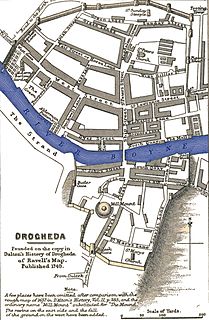This article relies largely or entirely on a single source .(May 2019) |
| |||||
| Centuries: | |||||
|---|---|---|---|---|---|
| Decades: | |||||
| See also: | Other events of 1652 List of years in Ireland | ||||
Events from the year 1652 in Ireland.
This article relies largely or entirely on a single source .(May 2019) |
| |||||
| Centuries: | |||||
|---|---|---|---|---|---|
| Decades: | |||||
| See also: | Other events of 1652 List of years in Ireland | ||||
Events from the year 1652 in Ireland.

Oliver Cromwell was an English general and statesman who led the Parliament of England's armies against King Charles I during the English Civil War and ruled the British Isles as Lord Protector from 1653 until his death in 1658. He acted simultaneously as head of state and head of government of the new republican commonwealth.

1657 (MDCLVII) was a common year starting on Monday of the Gregorian calendar and a common year starting on Thursday of the Julian calendar, the 1657th year of the Common Era (CE) and Anno Domini (AD) designations, the 657th year of the 2nd millennium, the 57th year of the 17th century, and the 8th year of the 1650s decade. As of the start of 1657, the Gregorian calendar was 10 days ahead of the Julian calendar, which remained in localized use until 1923.

The Tribes of Galway were 14 merchant families who dominated the political, commercial and social life of the city of Galway in western Ireland between the mid-13th and late 19th centuries. They were the families of Athy, Blake, Bodkin, Browne, D'Arcy, Deane, Font, Ffrench, Joyce, Kirwan, Lynch, Martin, Morris and Skerritt. Of the 14 families, 12 were of Anglo Norman origin, while two — the D'Arcy and Kirwan families — were Normanised Irish Gaels.

The Irish Confederate Wars, also called the Eleven Years' War, took place in Ireland between 1641 and 1653. It was the Irish theatre of the Wars of the Three Kingdoms – a series of civil wars in the kingdoms of Ireland, England and Scotland. The war in Ireland began with a rebellion in 1641 by Irish Catholics, who tried to seize control of the English administration in Ireland to force concessions for Catholics. This developed into an ethnic conflict between Gaelic Irish and old English Catholics on one side, and English and Scottish Protestant colonists on the other. Catholic leaders formed the Irish Catholic Confederation in 1642, which controlled most of Ireland and was loosely aligned with the Royalists. The Confederates and Royalists fought against the English Parliamentarians and Scottish Covenanters. In 1649, a Parliamentarian army led by Oliver Cromwell invaded Ireland and by 1653 had conquered the island.
Events from the year 1950 in Ireland.
Events from the year 1942 in Ireland.
Events from the year 1923 in Ireland.
Events from the year 1920 in Ireland.
Events from the year 1919 in Ireland.
Events from the year 1916 in Ireland.
Events from the year 1907 in Ireland.
Events from the year 1893 in Ireland.

The Cromwellian conquest of Ireland or Cromwellian war in Ireland (1649–53) refers to the conquest of Ireland by the forces of the English Parliament, led by Oliver Cromwell, during the Wars of the Three Kingdoms. Cromwell invaded Ireland with his New Model Army on behalf of England's Rump Parliament in August 1649.

Between 1639 and 1653, Scotland was involved in the Wars of the Three Kingdoms, a series of wars starting with the Bishops Wars, the Irish Rebellion of 1641, the English Civil War, the Irish Confederate Wars, and finally the subjugation of Ireland and Scotland by the English Roundhead New Model Army.

The Siege of Drogheda took place on 3–11 September 1649, at the outset of the Cromwellian conquest of Ireland. The coastal town of Drogheda was held by the Irish Catholic Confederation and English Royalists under the command of Sir Arthur Aston when it was besieged by Parliamentarian forces under Oliver Cromwell. After Aston rejected an offer to surrender, the town was stormed and much of the garrison was executed and an unknown but "significant number" of civilians were killed by the Parliamentarian troops. The outcome of the siege and the extent to which civilians were targeted is a significant topic of debate among historians.
The Battle of Scarrifholis was fought near Letterkenny, County Donegal, in the north-west of Ireland on 21 June 1650, during the Irish Confederate Wars. It was fought between the Confederate Ulster Army, commanded by Heber MacMahon, Roman Catholic Bishop of Clogher, and an English Parliamentarian army commanded by Charles Coote, 1st Earl of Mountrath and composed of troops from the New Model Army and local Ulster Protestant settlers. The battle resulted in the annihilation of the Ulster army and the loss of most of its weapons and supplies. This secured the north of Ireland for the English Parliament and contributed greatly to the Cromwellian conquest of Ireland.

The Anglo-Norman invasion of Ireland took place in stages during the late 12th century and led to the Anglo-Norman Kingdom of England conquering large swaths of land from the Irish. At the time, Gaelic Ireland was made up of several kingdoms, with a High King claiming lordship over the lesser kings. The Norman invasion was a watershed in the history of Ireland, marking the beginning of more than 800 years of direct English and, later, British involvement in Ireland.
Events from the year 1645 in England. This is the fourth year of the First English Civil War, fought between Roundheads (Parliamentarians) and Cavaliers.

Charles Coote, 1st Earl of Mountrath was an Anglo-Irish peer, the son of Sir Charles Coote, 1st Baronet, and Dorothea Cuffe, the former being an English veteran of the Battle of Kinsale (1601) who subsequently settled in Ireland.